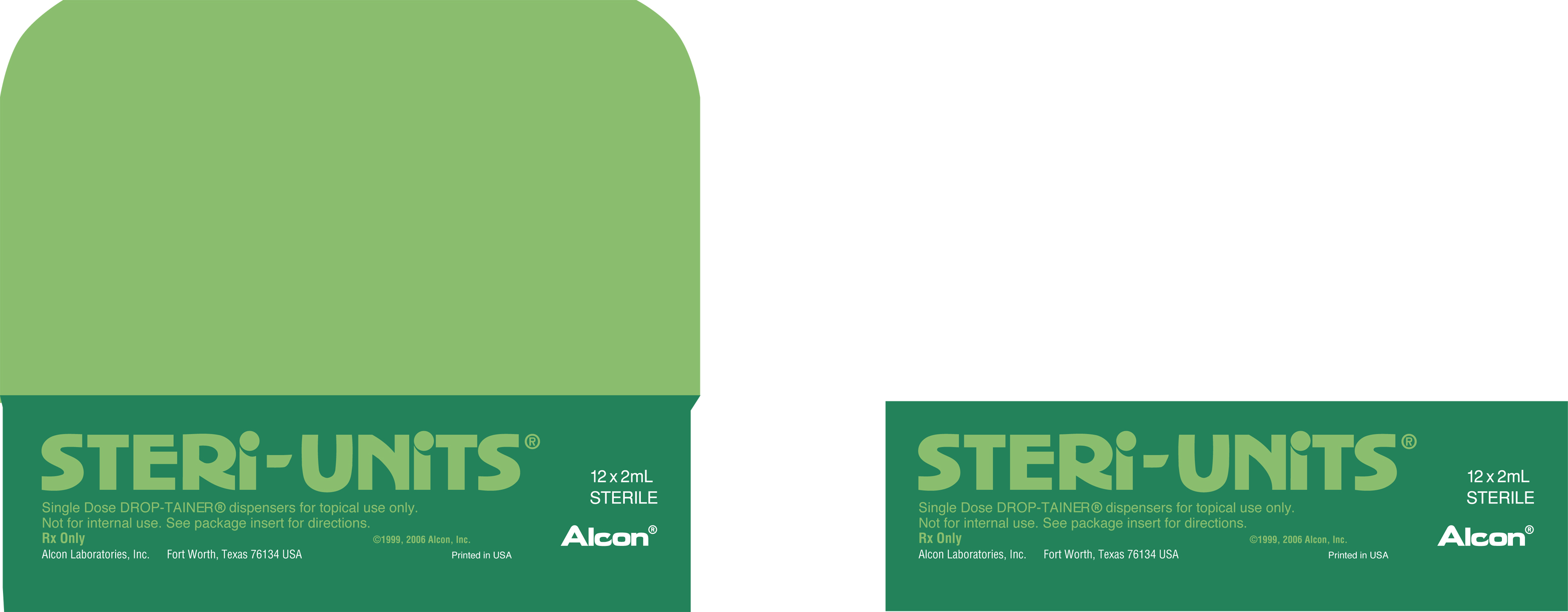ATROPINE SULFATE
-
atropine sulfate solution
Alcon Laboratories, Inc.
1. STERI-UNITS® Ophthalmic Solutions may be stored under ordinary conditions and handled freely prior to opening blister pack or vial without danger of contaminating the sterile surface of the enclosed DROP-TAINER® dispenser.
2. Open package using standard aseptic technique. The DROP-TAINER® dispenser may then be allowed to fall upon a sterile surface.
3. The entire outer surface of the DROP-TAINER® dispenser, as well as its contents, is sterile and thus may be safely handled by the surgeon or scrub nurse. The cap of the DROP-TAINER® dispenser is quickly and easily unscrewed; and the specially designed tip needs no puncturing before use.
4. Gentle pressure on the sides of the DROP-TAINER® dispenser will empty its contents in uniform drops.
There have been no long-term studies done using Atropine Sulfate in animals to evaluate carcinogenic potential.
Pregnancy Category C. Animal reproduction studies have not been conducted with Atropine Sulfate. It is also not known whether these ingredients can cause fetal harm when administered to a pregnant woman or can affect reproduction capacity. STERI-UNITS® Solutions containing these ingredients should be given to a pregnant woman only if clearly needed.
It is not known whether these drugs are excreted in human milk. Because many drugs are excreted in human milk, caution should be exercised when Atropine Sulfate or Pilocarpine Hydrochloride is administered to a nursing woman.
Safety and effectiveness in pediatric patients have not been established.
No overall differences in safety or effectiveness have been observed between elderly and younger patients.
Store Atropine Sulfate Ophthalmic Solution 1% at 46° - 80°F (8° -27°C). Protect from light.
ATROPINE SULFATE OPHTHALMIC SOLUTION 1%
The active ingredient is represented by the chemical structure:
Established name: Atropine Sulfate
Chemical name: Benzeneacetic acid, α-(hydroxy-methyl)-, 8-methyl-8-aza-bicyclo-[3.2.1]oct-3-yl ester,endo-(±)-, sulfate (2:1) (salt), monohydrate.
Each mL Contains: Active: Atropine Sulfate 1%. Inactives: Boric Acid, Sodium Hydroxide and/or Hydrochloric Acid (to adjust pH), Water for Injection.
This anticholinergic preparation blocks the responses of the sphincter muscle of the iris and the accommodative muscle of the ciliary body to cholinergic stimulation, producing pupillary dilation (mydriasis) and paralysis of accommodation (cycloplegia).
For mydriasis and/or cycloplegia. For cycloplegic refraction; for papillary dilation desired in inflammatory conditions of the iris and uveal tract.
Contraindicated in persons with primary glaucoma or a tendency toward glaucoma, e.g., narrow anterior chamber angle; and in those persons showing hypersensitivity to any component of these preparations.
For topical eye use only, not for injection. Use with extreme caution in infants, small children and geriatrics. Excessive use in children or in certain individuals with a previous history of susceptibility to belladonna alkaloids may produce systemic symptoms of atropine poisoning.
Patient should be advised not to drive or engage in other hazardous activities while pupils are dilated. Patient may experience sensitivity to light and should protect eyes in bright illumination during dilation.
To avoid excessive systemic absorption, the lacrimal sac should be compressed by digital pressure for two to three minutes after instillation. To avoid inducing angle closure glaucoma, an estimation of the depth of the angle of the anterior chamber should be made.
Prolonged use may produce local irritation characterized by follicular conjunctivitis, vascular congestion, edema, exudate, and an eczematoid dermatitis. Severe reactions are manifested by hypotension with progressive respiratory depression. Coma and death have been reported in young children. Increase in IOP may occur in patients with open angle glaucoma. Photophobia may occur with a fixed and dilated pupil. Decreased lacrimation may aggravate a dry eye condition.
Systemic atropine toxicity is manifested by flushing and dryness of the skin (a rash may be present in children), blurred vision, a rapid and irregular pulse, fever, abdominal distention in infants, mental aberration (hallucinosis) and loss of neuromuscular coordination. Atropine poisoning, although distressing, is rarely fatal even with large doses of atropine, and is self-limited if the cause is recognized and the atropine medication discontinued. Treatment includes supportive measures including maintaining a patent airway and assisting respiration if needed. Treat hyperthermia, coma and seizures if they occur.1 In infants and children, the body surface must be kept moist. Excitement may be controlled by diazepam or a short acting barbiturate. For ingestion, activated charcoal can be used to prevent drug absorption. If necessary, ipecac or another cathartic may be useful for drug removal during initial treatment.1,2 Physostigmine is used as an antidote to the systemic effects of atropine and may be administered parenterally to provide more prompt relief of intoxication. Parenteral physostigmine may be particularly useful in cases of pronounced hallucinations, agitation in which a patient may be dangerous to himself or others, arrhythmias resulting in uncontrolled hemodynamic instability, and intractable seizures.
One drop topically in the eye(s) as required, with care to avoid overdosage. Discard unused portion. May be used during ocular surgery.
2 mL in DROP-TAINER® dispenser in carton of 12.
NDC 0065-0702-12
1Kirk M, Kulig K, Rumack BH. Anticholinergics. In: Clinical management of Poisoning and Drug Overdose, Second Edition. Edited by Haddad LM, Winchester JF. Philadelphia, W.B. Saunders Company, 1990, p861-867.
2Tani SA. Anticholinergics. In: Poisoning and Drug Overdose, Second Edition. Olson KR. Norwalk, CT, Appleton & Lange, 1994, p75-76.
STERi-UNiTS®
Single Dose DROP-TAINER® dispensers for topical use only.
Not for internal use. See package insert for directions.
Rx Only
©1999, 2006 Alcon, Inc.
12 x 2mL
STERILE
Alcon®Alcon Laboratories, Inc.
Fort Worth, Texas 76134 USA
Printed in USA

|
ATROPINE SULFATE
atropine sulfate solution | ||||||||||||||||||
| ||||||||||||||||||
| ||||||||||||||||||
| ||||||||||||||||||
| ||||||||||||||||||
| ||||||||||||||||||
| Marketing Information | |||
| Marketing Category | Application Number or Monograph Citation | Marketing Start Date | Marketing End Date |
| unapproved drug other | 06/12/2022 | ||
| Labeler - Alcon Laboratories, Inc. (008018525) |
| Establishment | |||
| Name | Address | ID/FEI | Operations |
| Alcon Laboratories, Inc. | 008018525 | MANUFACTURE | |